Introduction
AMD has been a leader in Graphics chipsets and, at the time of writing this, the fastest GPU to date. Since the release of Intel’s SandyBridge design, Intel has held the mobile and hybrid computing markets. With that, AMD has responded with Llano: A GPU and CPU on the same die boasting graphics performance said to blow SandyBridge out of the water. This GPU/CPU combination, called an APU, is the next generation of almost every facet of computing. AMD’s response to SandyBridge might be a few years behind but it boasts solid computing and graphics at a price that won’t break the bank. AMD aims to price-point the A8 APU competitively with the i3 2100k (Retail $125) and the i3 2105 (Retail $140). With Llano, AMD is targeting gamers and media lovers with native 3D-HD, DirectX 11, and OpenCL acceleration. To this audience, Llano is a welcome sight.
With up to four 32nm “Stars” cores and up to 400 Radeon™ cores, the AMD A-Series APU offers the CPU performance of the former AMD Phenom™ II Processor combined with true AMD Radeon™ discrete-class graphics. In fact, our AMD A-Series APUs provide more graphics power than many entry level discrete cards, enabling an outstanding visual experience (see A-Series APU Performance Comparisons section).
Llano at first Sight
AMD’s new Llano platform, paired with AMD’s Fusion Controller Hub (FCH), represents AMD’s step to the next level of consumer-based computing. The APUs will have the ability to dynamically use Radeon cores for either computing or graphics depending on the tasks. This means more efficient switching between GPU and CPU usage as well as better performance all around. Llano supports DirectX11 with DirectCompute, HD-3D, AMD-Vision engine, UVD3, and OpenCL Acceleration. The upgrade to the use of an APU also has an effect on the motherboards market. AMD’s flagship motherboard chipset, the A75, will offer native Superspeed USB 3.0 and SATA 3.0. At release, AMD will be releasing 2 Llano APUs: the A8-3850 and the A6-3650. Both of these are 100w Quad-core solutions.

Pricing:
- $135/ea. A8-3850
- ~$TBA/ea. A8-3800
- $115/ea. A6-3650
- ~$TBA/ea. A6-3600
For this review we have the A8-3850 and will bring you reviews of subsequent APU’s when they are made available.
Llano in-depth
Llano represents the combination of a Northbridge, Quad-core CPU, and a Directx 11 GPU on one die. While this layout is quite similar to Intels SandyBridge design, Intel lacks the quality and performance of the GPU that AMD brings to the table. It remains to be seen if the Llano is the better chip both computationally as well as graphically.
With this new chip comes some really outstanding features.
- AMD Turbo Core technology dynamically adjusts the CPU and GPU cores according to load. So if you’re running an intensive computational application, the APU will pull Radeon cores to help take the load. This feature maximizes performance allowing the user to smoothly change between GPU and CPU based applications
- AMD Accelerated Parallel Processing
- Dual Graphics (also known has Hybrid Crossfire) allows the user to put a Discrete Radeon card on the platform and use it in Crossfire. This means both GPUs (One on the APU and the discrete) are both working on the graphics for 1 monitor (or Eyefinity, depending on setup). This allows the APU to focus more on CPU threads. During preliminary testing, AMD has come up with results from 3fps to 20 fps difference from just using the APU. Below is a list of current supported configurations:
Overclocking
The chip we received is multiplier locked meaning I am unable to overclock via CPU-Multiplier. The only way I am able to overclock is bus speeds which effectively overclocks the whole whole platform (Motherboard and RAM). This leaves some things to be desired and shows that this APU, while a large leap in the correct direction from AMD, is still a young project. Whether AMD has this locked in fear of power management (100w max) or as a re-brand release, Llano won’t be considered by people looking to boost the performance of a stock rig until AMD unlocks these APUs.
AMD Vision Engine
With the release of this new generation of APU’s, AMD has also upgraded their engine to the Vision Engine. This engine has added upgrades to current technology in the fields of shader configurations (also called Radeon core usage) and Universal Video Decoder (UVD3). While these are nice, their flagship accomplishment (and something I’m really looking forward to watching grow) is their image stabilization technology. This will dynamically cut frames out of a shaky video (Home video for example) and display a cleaner video. This currently does not support saving the “clean” file, only playback. With that aside, it looks promising.

Powering these features is the APU. Lets take a look at its specs:
- Technology:32nm
- Power Usage:100w
- Cores:4 “Stars”
- CPU Clock:2.9GHz
- L2 Cache:4MB
- Max RAM Speed:1866MHz
- Graphics: 400 Radeon Cores, Directx 11, UVD3
- Graphics features:AMD Dual Graphics (Hybrid Crossfire)
- Graphics Ports:DVI-d, DP 1.1a, HDMI 1.4a
- Graphics Clock:600Mhz
- Max Compute Speed:480GFLOPS
- Software Support:Windows 7, Windows Vista, Windows XP, Linux
A 2.9 Ghz clock on 4 cores is comparative to the performance you would receive out of a Phenom quad, so not much of a difference there from what AMD already offered. However, a 400 core 600MHz clock on the GPU side is quite the step up from the SandyBridge onboard GPU. Again, AMD is targeting the graphics lovers. Not the computational speed lovers with this APU. SandyBridge is meant to make Windows look pretty. Llano is meant to make Windows look amazing and provide the media and gaming ability to the end user.
Lets move on to the benchmarks to see how this chip stacks up.
Test Rig
- Motherboard: Asus F1A75M-Pro
- APU: A8-3850
- RAM: 4 gigs DDR3 Partiot Sector 7 @ 1066
- CPU Cooler: Coolermaster 140mm
- PSU: Coolermaster 550w
- Case: Coolermaster HAF 922
- Discrete card (where applicable): Radeon 6670 Ultimate
- Storage: 64GB Kingston SSD-now, 500gb WD Caviar
- OS: Windows 7 Professional
For these tests, I did one with only the APU and another with my 6670 in Hybrid Crossfire. AMD showed a 10-20 fps jump when they added a 6570 discrete and retested. I wanted so see if I could achieve similar results.
3D Mark Vantage
Link: 3DMark Vantage
3D Mark is an industry wide benchmark testing frames per second and computations per second of the CPU and GPU combination. Here, we see a large jump from normal APU to the Crossfire tests. By all accounts, the 2705 the GPU scored in the APU test is comparable to entry-level Radeon cards (such as the 6550D included in the A8).
A 3DMark score is an overall measure of your system’s 3D gaming capabilities, based on comprehensive real-time 3D graphics and processor tests. By comparing your score with those submitted by millions of other gamers you can see how your gaming rig performs, making it easier to choose the most effective upgrades or finding other ways to optimize your system.
PCMark Vantage
Link: PCMark Vantage
PCMark is a tool used to test the efficiency of the whole system in a gaming atmosphere. The 7859 achieved here with the APU is dragged down by the fact the APU is changing back and forth between graphics performance and computational performance. We see, when we add the Crossfire test, the score jumps dramatically.
Furmark
Link: Furmark
Furmark is a GPU test designed to test the thermal and performance limits of a card. Here I did both 720p and 1080p tests with both just the APU and in Crossfire. We can see that this chip isn’t meant for high end gaming which matches our original assumptions.
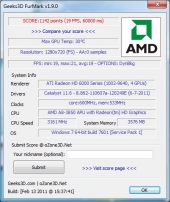 720p Test in Crossfire |
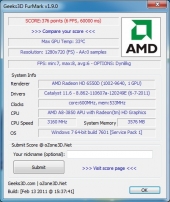 720p Test on APU |
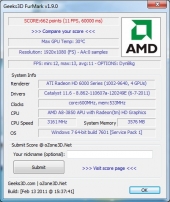 1080p Test in Crossfire |
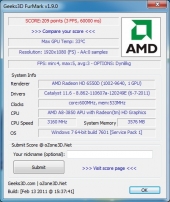 1080p Test on APU |
Cinebench
Link: Cinebench
Cinebench is another tool used to test the efficiency of the GPU/CPU combination.
CINEBENCH is a real-world cross platform test suite that evaluates your computer’s performance capabilities. CINEBENCH is based on MAXON’s award-winning animation software CINEMA 4D, which is used extensively by studios and production houses worldwide for 3D content creation.
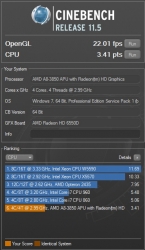 |
 |
PassMark Performance Test
Link: PassMark
PassMark is a tool that tests everything on the computer rig. From RAM timings to DVD read times, this tool does it. We did get some large performance jumps when we tested in crossfire. Pay attention more to the breakdown of scores for each test rather than the overall score.
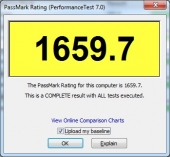 Test in Crossfire |
|
Final Synthetic Results
As we can see, the APU held it’s own here. We can take away from these that the APU alone can perform as a 5-series Radeon card. But when that is paired with a 6-series card, the performance really jumps in both GPU and CPU results.
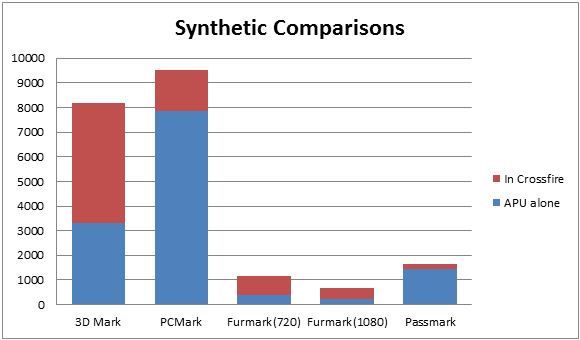
Gaming Benchmarks
When AMD sent me this APU, they included some of their own testing comparing Crossfire to APU performance. Following their lead, I did a couple tests myself on games I felt they left out and a couple games I didn’t quite believe their results (Metro 2033 especially). My results were quite surprising: they really have done a great job with using the APU in Hybrid Crossfire (also known as Dual Graphics). In some of my gaming benchmarks, adding a mid-level Radeon card turned games playable on medium-high settings. AMD has made the APU capable of playing today’s recent games (albeit not the best settings) while still having the computing power of a Phenom. On top of that, they’ve kept the price competitive.
*in AMD’s tests, they used a Radeon 6570 in Crossfire to test.
AMD’s Results:
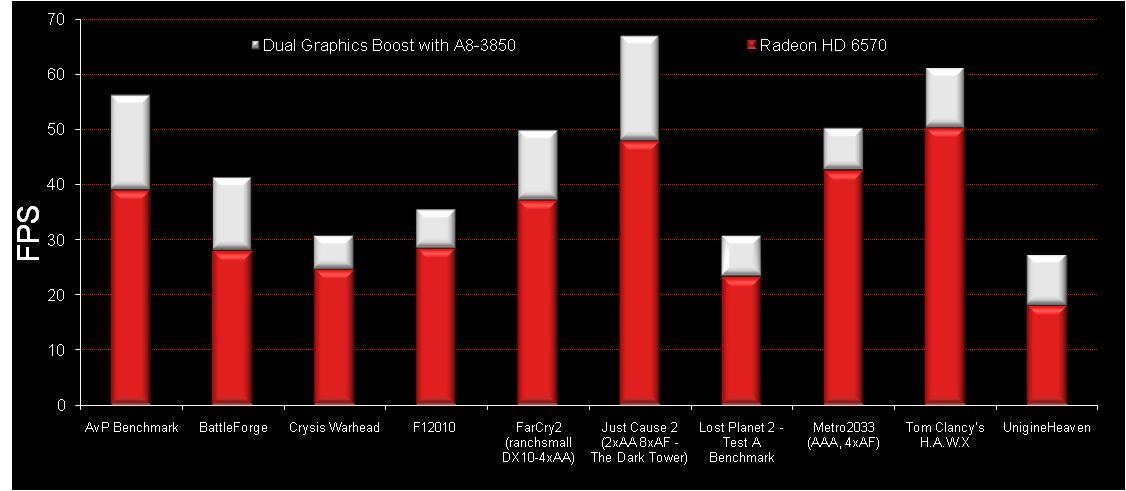
My Results:
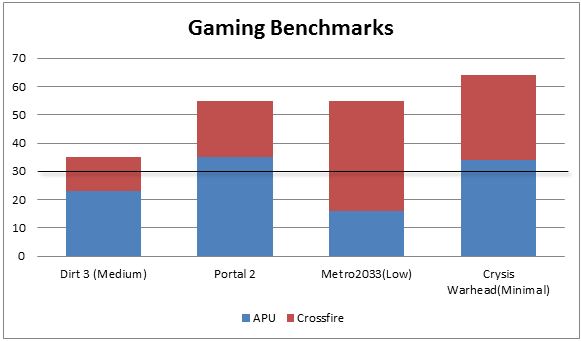
*for both of these, 30fps is considered desirable for gaming
AMD has the answer for SandyBridge, and it isn’t in the form of a 16-core monster. AMD has created a CPU/GPU combination for the user: One that displays stunning HD video in both 2D and 3D and has the ability to play todays’ games in an Eyefinity setup. AMD has set this at a price-point where having an eye-popping graphical display isn’t dependent on the price of a high performance costly video card. With the APU showing what it has, I have no doubt the A-series will be the money-wise option for consumer desktops without sacrificing performance. Make no mistake, this isn’t aimed at the gamers fixated on Ultra graphic settings; That’s not saying it can’t be modified to future demands with Hybrid Crossfire. With this APU hitting the market also brings native (so far only native on the A75 chipset) USB3.0 and SATA6.0 which are also a welcome sight. AMD has not only answered the call from the consumer, but come up with an APU customized for the consumer. This is a welcome sight to media-enthusiasts alike, however I feel this chip has to do some growing in order to make it completely mainstream. I feel AMD has locked this chip because of the entry-level of power management. 100w Maximum on a quad-core leaves some things to be expected. For that, I am awarding this our “Awesome Hardware” award.

Editors Note: Llano is the fruit of the union between AMD and ATI and while the chip is its early stage of maturity is proves what AMD brings to the table. Considering the high end A8-3850 APU hits the market with a sub $150 US price it is nothing less than remarkable that this APU combines a quad core CPU with a mid range 6550d Radeon card at a 100W TDP. If AMD improves upon the computational power of the A series CPU we could be looking at a game changer. As it stands the A series should be a no brainer choice for consumers seeking more graphical power at a cheaper price. The implementation of the Llano for notebooks or Sabine has already hit chelves and demonstrates the cost saving that AMD brings consumers. Gamers seeking shelter from Nvidia could well flock in droves to the new A series.


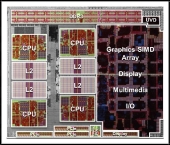
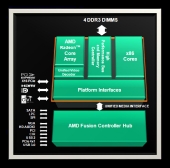
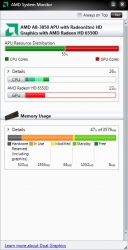
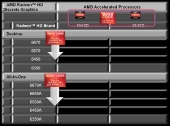




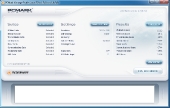
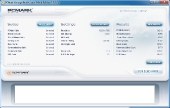
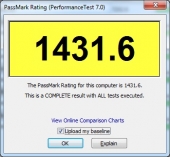
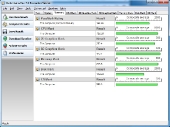
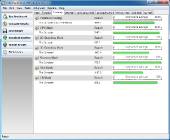

In addition,we conducted several debugging with GPU overclocking,finally we found out that thought it could enter system easily in core frequency of 800MHz(default frequency of 600MHz)